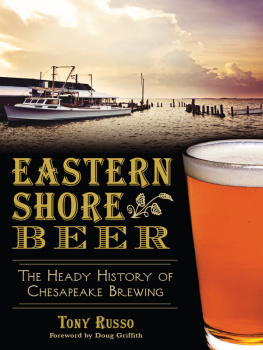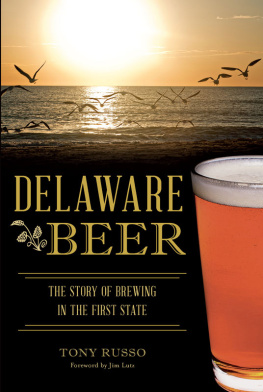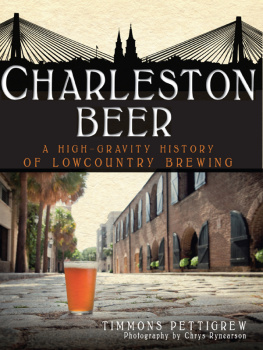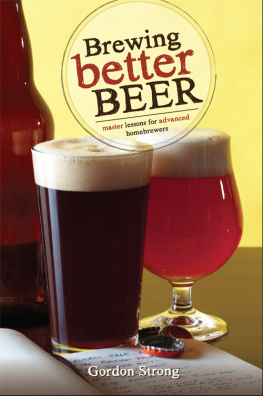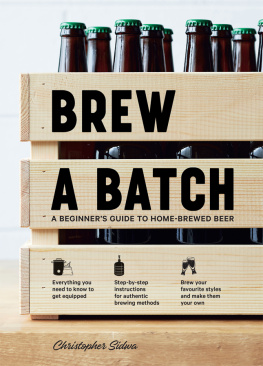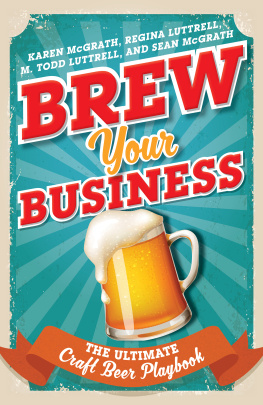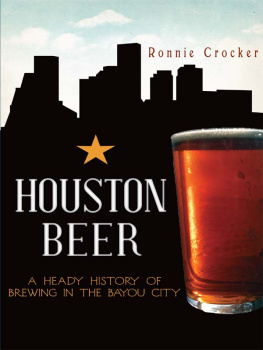

Published by American Palate
A Division of The History Press
Charleston, SC 29403
www.historypress.net
Copyright 2014 by Tony Russo
All rights reserved
First published 2014
e-book edition 2014
ISBN 978.1.62585.270.0
Library of Congress Control Number: 2014951889
print edition ISBN 978.1.62619.741.1
Notice: The information in this book is true and complete to the best of our knowledge. It is offered without guarantee on the part of the author or The History Press. The author and The History Press disclaim all liability in connection with the use of this book.
All images by Kelly Russo unless otherwise noted. All rights reserved. No part of this book may be reproduced or transmitted in any form whatsoever without prior written permission from the publisher except in the case of brief quotations embodied in critical articles and reviews.
CONTENTS
FOREWORD
Beer is a part of life. Many of us enjoy a beer or two after a long day at work or sometimes when the mood hits. These days, we take for granted most of the beer varieties that are readily available with only a short trip to the grocery or liquor store. This is not the way it was for most of our history here in the United States and especially on Delmarva and the Eastern Shore of Maryland.
My association with beer began more than forty years ago in Baltimore. National, Shaeffer, Arrow and Carling were some of the local Baltimore breweries that I remember when I first started drinking beer. Baltimore, like all larger cities, has always had a large presence of breweries, but until about the last thirty years, good beer was hard to find on the Eastern Shore. This was also true of the homebrew community. I started homebrewing in the late 80s. At that time, there was only one brewery on the Delmarva PeninsulaWild Goose in Cambridge. The trend with most breweries was to go with a lighter beer, which meant less flavor. I wanted flavor and body, which I was able to get from my homebrewing. In 1995, I opened a homebrew store in Millsboro, Delaware, to supply myself and other local homebrewers with materials. The same year, Sam Calagione opened the Dogfish Head Brewings and Eats in Rehoboth Beach. An article in the newspaper about the soon-to-be-opening business had me at the soon-to-be brewpub. Looking through the front window, I had my first encounter with Sam. Although we had never met, he knew of the homebrew store and me.
I found out that he could use some help getting the restaurant ready for opening. During the next four years, I was able to help Sam with various aspects of his brewing adventures. Through some advertising and lots of word of mouth, our homebrew store grew, and so did our customers and their desire for more brewing information. In addition to our beginners extract-brewing classes, we started doing all-grain brewing sessions two or three times a year to help our customers progress from malt extract brewing to all-grain brewing. Even some of the local professional brewers (Jay Talkington, Joe Lemnah and John Panasiewicz from 3rd Wave) would help with the all-grain classes, as well as classes on other brewing topics. Eventually, some of our customers either opened their own breweries or brewed for a commercial brewery:
Brad Moyer, Appalachian Brewing, Lancaster, Pennsylvania
Josh Campbell, Tractor Brewing, Albuquerque, New Mexico
Brian Brushmiller, owner, Burley Oak Brewery, Berlin, Maryland
Aaron Miller, Burley Oak Brewery, Berlin, Maryland
Vince Wright, owner, Fin City Brewery, Ocean City, Maryland
Lori Clough, owner, 3rd Wave Brewing, Delmar, Maryland
Jerry Franklin, 3rd Wave Brewing, Delmar, Maryland
Jimmy Sharp, Tall Tales, Parsonsburg, Maryland
Eric Camper, Tall Tales, Parsonsburg, Maryland
We have been pleased to see so many of our customers advance the commercial brewing industry on Delmarva and other places in the country. I feel fortunate to know Tony; he has a true passion for beer. Now he will lead you through the history and progression of beer on the Eastern Shore.
DOUG GRIFFITH
Doug Griffith has been in the homebrewing business for more than twenty years as the owner of the famed Xtreme Brewing, formerly Delmarva Brewing Craft. In addition to having worked on some of the earliest iterations of the Dogfish Head brew house, he has trained hundreds of people to brew beer and wine and to appreciate the process. He lives in Millsboro, Delaware, with his wife, Patti.
PREFACE
Very little is known about Peter Underwood, which kind of is a shame. Peter was a workaday Joe who fell into the tavern business in the 1670s in Maryland. The guesses I was forced to make about him as a student (and again while researching this book) were reasonable, based on general facts about how life was at the time, but they were guesses all the same. I met Pete by accident when I was in college. He was to be the subject of one of the four major papers I had to write as a history student, but there wasnt enough information about him, so I had to expand that paper to include western shore people. It was one of the great frustrations I had as a student, and it stuck with me.
Just a few years later, I was working as a reporter for the Bayside Gazette in Berlin when I heard there was a brewery scheduled to open across the street. I lived in Delmar, Maryland, and was a huge fan of the recently opened Evolution Craft Brewery, so I walked across the street and introduced myself to Bryan Brushmiller. At the time, Bryan expected to be making beer by November 2010 (he only was off by about ten months), and we got to talking about the process. I wrote the occasional story about his various plans, but by the time he opened, I had more than just a little bit of information. For the next year, I interviewed Bryan for about an hour a week, both on the Happy Hour Todcast podcast and privately for publication of a book I was working on. If Peter Underwood was under-documented, Bryan would be over-documented.
The result wasnt only a massive nonfiction narrative but a new cultural understanding. I applied this insight to the breweries on the Eastern Shore, realizing the privilege my particular position granted me. Already being in possession of the background knowledge of how the Eastern Shore responded to the earliest growth of owner-operated taverns put this latest revolution in better context. Add to that the perspective I had gained in covering the boom and bust of the real estate crash, and it became impossible for me not to see the parallels. These parallels revealed a more complex picture of the history of the independent brewer on the Eastern Shoreone that painted the Eastern Shores current craft beer revolution as a cyclic stimulus-response, a child standing in the center of a backyard pool, jumping up and down flapping her arms in an attempt to make larger waves.
What many of these brewers had in common was that they understood not only that a craft beer wave was coming but also that it required a special kind of handling, an authenticity and mutual support that few other businesses require. The earliest participations in the craft revolution, the mavens, enjoyed talking with the brewers as much as they did drinking the beer. A brewers willingness to participate with the people could make or break his brewery. Especially in the early days, when the beers can be a little inconsistent, if a brewer is personable and convinces people of his passion and authenticity, the beer will get more leeway. Craft beer is sociala communal thing for people to get behind. Once youre behind it, it is something many people defend and promote with a passion.
Next page
